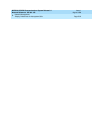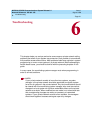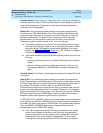
MERLIN LEGEND Communications System Release 6.1
Network Reference
555-661-150
Issue 1
August 1998
Troubleshooting
Page 6-2Troubleshooting Guidelines and Preparation
6
Troubleshooting Guidelines
and Preparation 6
Before troubleshooting problems, obtain copies of your system’s planning forms.
Many of the solutions offered in this chapter require that you contact the
coordinating system manager in your private network, who maintains records of
how systems in your private network are programmed and keeps them up to date.
Problems can occur when changes are made in a private network without
considering the needs of the private network as a whole. In particular, changes to
local and non-local dial plans, Uniform Dial Plan (UDP) routes, Automatic Route
Selection (ARS) routes, and remote access settings can have unintended effects
on other systems in your private network.
To solve a problem, you may need to perform system programming using your
MLX-20L programming console or PC equipped with System Programming and
Maintenance (SPM) software.
Most of the problems outlined here can be solved by system managers working
together in a two system private network or with the coordinating system manager
in a larger private network. However, some problems require the intervention of a
Lucent Technologies technician. In the USA only, Lucent Technologies provides a
toll-free customer Helpline (1 800 628-2888) 24 hours a day. You may want to
allow only the coordinating system manager to contact the Helpline, because this
person has the complete information that allows Lucent Technologies technicians
to understand problems that you are experiencing. Under certain circumstances,
you may be charged for consultation with Helpline personnel. Contact your Lucent
Technologies representative or authorized dealer, if you have any questions
concerning consultation charges.
The troubleshooting instructions in this chapter provide information about
reviewing current programming on your local system. You can find out about
current programming in the following three ways:
■ System Forms. Review the filled-out system form that includes the
programming information you need. This method requires that forms be
available and up-to-date.
■ System Reports. Appendix B, “Sample Reports,” includes samples of
reports that you may require when troubleshooting private network
problems, along with the menu options for selecting each report. To see a
report, select the
3ULQW option on the System Programming menu and then
choose a report. The
Feature Reference
, Appendix F, includes samples of
all system reports.
■ System Programming. Many of the system programming procedures that
you may need to perform are summarized in Chapter 5, “Network
Management.”
System Programming
includes instructions for accessing
system programming by using the MLX-20L console or SPM software on a
personal computer. The troubleshooting instructions also cite procedures
from
System Programming
.


















